Menu
Airport to Dambulla – Handloom factory Visit , Pottery Station Visit , Sigiriya.
Dambulla to Trincomalee – Visit Polonnaruwa , Lesiure at Trincomalee , Koneswaram Kovil , Explore Trincomalee.
Trincomalee to Kandy – Dambulla Cave temple , Spice Garden , Dalada Maligawa.
Kandy to Nuwara Eliya – Tea Factory Visit , Ramboda Falls , Hanuman Temple , Explore Nuwara Eliya.
Nuwara Eliya to Ella -Seethaamman Kovil , Little Adam’s Peak , Explore Ella.
Ella to Galle – Ravana Falls , Galle Dutch Fortress.
Departure – Stilt Fisherman , Turtle Hatchery , Maadu River Boat Safari.
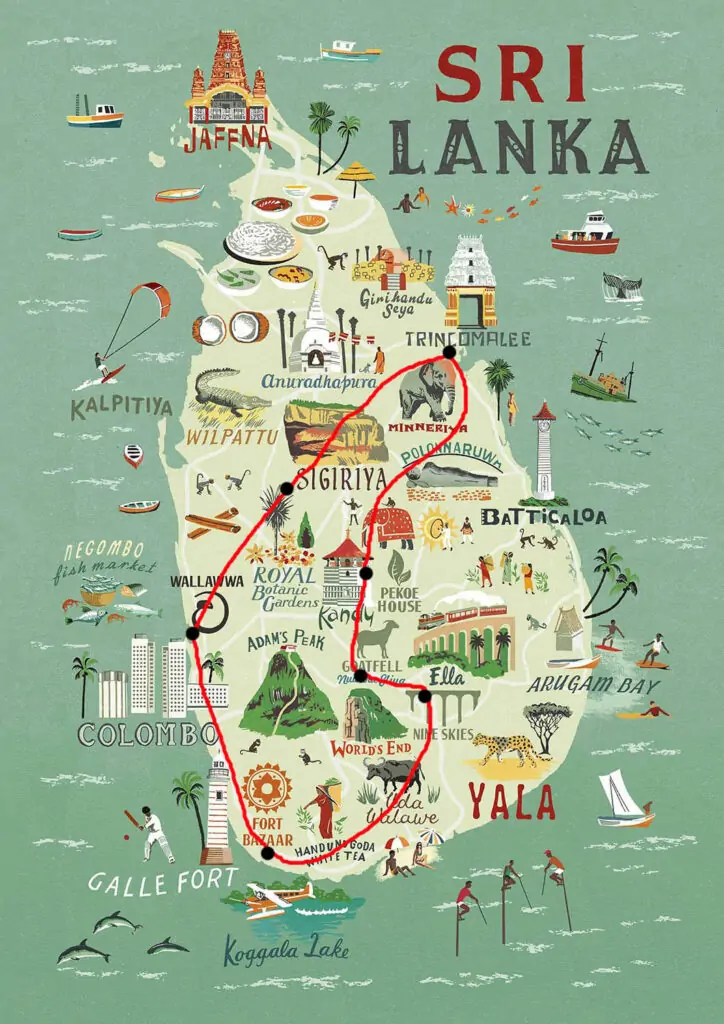
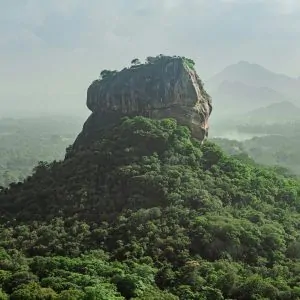
Handloom factory
A handloom factory in Sri Lanka is a traditional textile manufacturing facility that produces high-quality fabrics using manual weaving techniques. Skilled artisans operate handlooms to create a wide range of textiles, including saris, clothing, and home furnishings. These factories play a significant role in preserving Sri Lanka’s rich cultural heritage and provide employment opportunities for local craftsmen, contributing to the nation’s economy while producing unique, artisanal products.Independence Square
A historic landmark honoring Sri Lanka’s 1948 independence from British colonial control is situated in Colombo. The square is surrounded by lush gardens and strolling routes, and it boasts a stunning monument that combines aspects of indigenous and colonial architecture. It is a well-liked public area for both residents and visitors, providing a calm setting for relaxation and contemplation in the middle of the city.
Be a traditional Potter & do your own Pot
One of the first and most thriving industries in ancient Sri Lanka was pottery. There existed a caste specifically for potters in Sri Lanka’s caste system of government. There were potters with skill and imagination everywhere in the nation. You won’t miss the pottery that was made in several of the settlements. You will go to a traditional pottery village and discover the various trade secrets associated with this art form. The most incredible will be creating your own pot with clay and conventional machinery. Remember to put your name on the pot you’re taking home
Sigiriya Rock Fortress
Unforgettable architecture, steeped in history and culture. Built over a thousand years ago by a king hiding from the reckoning of his patricide, Sigiriya (or the “Lion’s Rock”) is a historical site that was once both an ancient castle and impenetrable fortress, with symmetrical water gardens.
Your trek up the rock will take you past timeworn paintings of the king’s concubines, and past a gateway guarded by the remains of a giant lion statue that gave the rock its name. You’ll have to climb up around 1,200 steps to reach the top. Sigiriya is one of Sri Lanka’s most iconic attractions, and is definitely not to be missed.
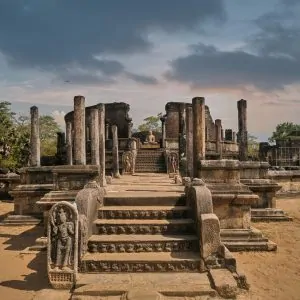
Visit Polonnaruwa
Visit polonnaruwa the second capital of sri lanka from 1070 A.D to to 1235 A.D. polonnaruwa is also a UNESCO world heritage city. You will be able to see the ruins of royal palace king Parakramabahu, Audience hall, the statue of king Parakramabahu, Watadage , Galpotha , Parakrama samudraya witch was built by King Parakramabahu 1 , covers an area of 5940 acres and the elegant lotus pond was built in 12th century.
There are also famous monuments of worship such as the Gal Viharaya wich has 4 magnificent carved Buddha statues, Kiri Vehara (the remains of a former Temple of the tooth Relic) and Shiva Temple.
Leisure by the Beach Hotel at Trincomalee
The world’s finest white sand beaches are found in Sri Lanka. It has long been a well-known beach location for beach enthusiasts. Savor a mouthwatering feast of sea delicacies while catching a sight of the warm Indian Ocean. In the West Coast, the beach hotels are dispersed from Tangalle to Chillaw. As soon as you step into the stunning blue water, you will fall in love with this idyllic place.
Explorer Trincomalee
Trincomalee, a coastal town on the northeastern tip of Sri Lanka, is a hidden gem waiting to be discovered by tourists. Trincomalee offers a unique and unforgettable travel experience. Whether you seek relaxation on pristine beaches, exploration of historical sites, or adventure in the water, Trincomalee has something for everyone.
Trincomalee is renowned for its pristine beaches, each with its own unique charm. Nilaveli Beach, with its turquoise waters and soft sand, is a paradise for swimming, sunbathing, and water sports. Uppuveli Beach, known for its vibrant cafes and restaurants, is perfect for relaxing and enjoying the local atmosphere. Marble Beach, with its smooth, white sand and calm waters, is a secluded haven for nature lovers.
Trincomalee has a rich history dating back centuries, evident in its numerous ancient temples, forts, and monuments. Koneswaram Temple, a Hindu temple dedicated to Shiva, is a stunning architectural marvel perched on Swami Rock. Fort Frederick, a Portuguese-built fort offering panoramic views of the town and harbor, is a testament to the region’s colonial past. The Trincomalee War Cemetery, a poignant reminder of World War II, is a place for quiet reflection.
The Thirukoneswaram temple
The Thirukoneswaram temple is a classical medieval Hindu temple complex located in Trincomalee, Sri Lanka. It is considered to be one of the five “PanchaIshwarams” (abodes of Shiva) and is a major pilgrimage center for Hindus. The temple complex is located on a rocky promontory overlooking the sea and offers stunning panoramic views.
The temple has a long and rich history, dating back to the 3rd century BCE. It was originally built by the Chola kings and was once a vast temple city with many smaller temples. However, the temple was destroyed by the Portuguese in the 17th century and only the main shrine remains today.
The Thirukoneswaram temple is a beautiful and serene place, and it is definitely worth visiting if you are in Trincomalee.
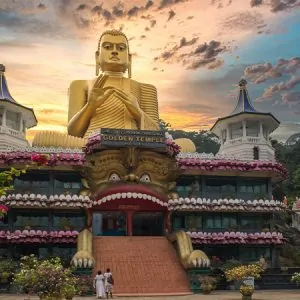
Dambulla Cave Temple
King Walagamba constructed the Dambulla Rock Temple in the first century B.C. The largest and best preserved cave temple complex, spanning an area of approximately 2,100 m², is the main draw of Dambulla. A UENESCO World Heritage Site is Dambulla. Aside from the 153 Buddha statues dotted around the five caverns and the remarkably maintained paintings, there is nothing quite like the breathtaking vista of the boundless plains and reservoirs.
visit a spice garden
Visit a Matale spice garden to observe the many spices that Sri Lanka is renowned for. Muslim traders controlled the Indian Ocean’s spice trade routes during the Middle Ages. Spices were more than just food flavorings, therefore they were highly prized. They were also utilized as food preservatives and medications. In ancient times, ceylon cinnamon was well worth its weight in gold. Visitors will be able to witness the cultivation and processing of various spices. Watch demonstrations of cooking as well.
Kandy temple
The Kandy DaladaMaligawa, also known as the Temple of the Sacred Tooth Relic, is a renowned Buddhist temple in Kandy, Sri Lanka. It houses a relic believed to be a tooth of Lord Buddha. The temple is an important pilgrimage site and a UNESCO World Heritage site, known for its cultural and religious significance.
Sri DaladaMaligawa is highly revered and significant to Buddhists worldwide. The building combines elements of the DaladaMandira with the distinctive Kandyan architectural style. Intricate gold, silver, bronze, and ivory carvings embellish the temple.

Visiting a tea factory
Visiting a tea factory in Sri Lanka is a must-do for any tea lover or anyone who wants to experience the country’s rich history and culture. Sri Lanka is the world’s fourth-largest tea producer, and its lush hill country is home to some of the most beautiful tea plantations in the world.
No matter which tea factory you choose to visit, you’re sure to have a memorable experience. Here are a few things you can expect to see and do on a typical tea factory tour: Watch the leaves being withered, rolled, fermented, and dried. Learn about the different grades of tea. Enjoy a tasting of different Ceylon teas
Ramboda Ella waterfall
The Ramboda Ella waterfall is a beautiful sight, and it’s definitely worth to visit.
The waterfall is actually a series of three falls, with the tallest one being 109 meters high. The middle fall is the most popular swimming spot, and the lower fall is the easiest to get to. The Ramboda Falls Hotel is right next to the lower fall, and the Blue Field Tea Factory is a short drive away. For the second fall, need to do little hike. The Ramboda Falls Hotel is right next to the lower fall, and the Blue Field Tea Factory is a short drive away.
Sri Bhaktha Hanuman Temple
Built in reverence of Lord Hanuman, this wonderful holistic site overlooks the verdant Ramboda valley. One of the greatest sculptures created by the artists of the era is the 19-foot statue that depicts Lord Hanuman pleading with Lord Rama. Gorgeous mountains, an infinite tea field, and a cool, comfortable temperature all contribute to the wonderful sense you get when you arrive to the temple. The Sri Bhaktha temple is worth visiting whether or not you identify as a Hindu.
Explore NuwaraEliya
NuwaraEliya, located in Sri Lanka’s central highlands, is a charming hill station renowned for its lush tea plantations, cool climate, and breathtaking landscapes. Often referred to as “Little England,” it offers visitors picturesque views, colonial architecture, and a serene atmosphere, making it a popular destination for nature lovers and tea enthusiasts.
Things to Do – Post Office /Single Tree Hill / Lake Gregory / Queen Victoria Park / Moon Plains / Hakgala Botanical Garden / Seetha Amman Kovil
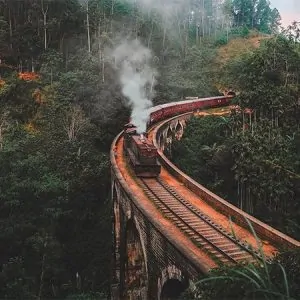
Seethaammankovil
The Seetha Amman Kovil in NuwaraEliya, Sri Lanka, is a sacred Hindu temple nestled amidst lush greenery. It is dedicated to Goddess Seetha, a central character in the Indian epic, Ramayana. Pilgrims visit to pay their respects and immerse themselves in the temple’s serene and spiritual atmosphere.
Nine Arch Bridge
The Nine Arch Bridge in Ella, located in Sri Lanka’s Uva Province, is a stunning architectural marvel nestled amidst lush green hills. This iconic bridge, built during the British colonial era, features nine picturesque stone arches that span a picturesque valley, creating a popular attraction for tourists seeking breathtaking views and historical charm.
Before you go check on the train schedule and start the trekking 30 minutes earlier. However, be sure to carry your trusty cam with you so that you might capture every moment that unravels before you.
Little Adam’s Peak
Little Adam’s Peak is a picturesque hill located in Ella, Sri Lanka. Standing at 1,141 meters above sea level, it offers breathtaking panoramic views of lush green tea plantations, dramatic landscapes, and the iconic Ella Rock. A popular hiking destination, it’s a relatively easy trek, making it perfect for nature lovers and photographers seeking stunning vistas.
It is not a challenging hike and it`s quite short, but gives you a good impression of the landscape around Ella and the view is fantastic! So absolutely worth the climb! If you don`t have that much time in Ella, we highly recommend taking the hike up to Little Adam`s Peak.
Ella Sri Lanka
Ella is a charming town located in the Uva Province of Sri Lanka. Nestled amidst lush green hills, it’s renowned for its picturesque landscapes, tea plantations, and the iconic Ella Rock. Visitors can enjoy stunning hikes, waterfalls, and a laid-back atmosphere in this idyllic corner of the Uva Province. And Ella well-known for the world’s most beautiful train ride also.
Things to do – Ella Rock hike / Nine Arch Bridge / Little Adam’s Peak / Flying Ravana Mega Zip line
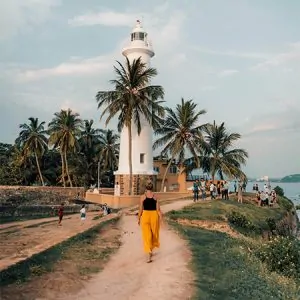
Ravana waterfall
Ravana Falls, located near Ella in Sri Lanka, is a magnificent waterfall cascading from a rocky cliff. Standing at 82 feet (25 meters) tall, it is surrounded by lush greenery and is a popular tourist attraction. According to local folklore, Ravana Falls is associated with the epic tale of the Ramayana, making it a culturally significant site.
Galle Dutch Fortress
Since the 14th century, Galle has been Sri Lanka’s principal port. The Portuguese constructed Galle’s first fort. Enjoy the breathtaking view of the ocean as you stroll along the fort’s walls, and don’t forget to watch the sun set for an even more breathtaking vista from the Galle walls.
Galle Fort is the most beautiful coastal town in Sri Lanka. Here, h a unique fusion of European and Asian influences, as seen in the whitewashed Dutch-style buildings that line the cobbled streets. Head to the most southwestern corner of the country and enjoy all the beautiful things to do in Galle Fort, Sri Lanka. The story of the Galle Dutch Fort; a UNESCO World Heritage Site reverberates through every traveller’s photos and captions. Initially built by the Portuguese in the 16th century during their conquests, the fort was later fortified and conquered by the Dutch in the 17th century, until it later fell to the might of the British. The old town of Galle was once used as a trading port for spices and other goods for over 200 years. However, today, the fort has been transformed into a place of history, romance and beauty where travellers are warmly welcomed to dive head first into the exotic stories and be a part of this heritage site
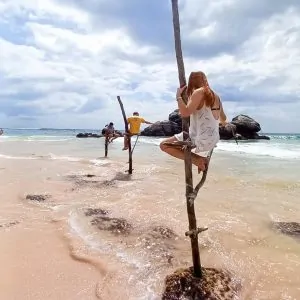
The stilt fishermen
The stilt fishermen of Koggala are a unique and iconic sight along the southern coast of Sri Lanka. Perched atop slender poles jutting out into the Indian Ocean, they cast their lines into the shallow waters, silhouetted against the vibrant orange and pink hues of the sunrise or sunset.
While the practice of stilt fishing has been around for centuries, its exact origins remain unknown. Some believe it was introduced by foreign traders, while others claim it was developed locally as a way to fish in shallow waters where boats couldn’t go.Today, stilt fishing is more of a cultural attraction than a primary source of income for the fishermen. However, it still offers a glimpse into a traditional way of life and provides a memorable photo opportunity for visitors.
The best time to see them is in the early morning or late afternoon, when the light is best for photography.
Turtle hatchery
Hawksbill, Olive Ridley, Loggerhead, Green, and Turtle are the five species of sea turtles that can be found in Sri Lanka. The Galle District contains all of the important nesting areas. You’re going to a hatchery, where the locals gather eggs to hatch and feed the young turtles.
Here you will find lots of information about Sri Lanka’s pioneering sea turtle conservation project – why Sri Lanka is a prime turtle nesting site, why the conservation project is needed and how the project is operated by local people with the help of international volunteers.
Maadu river Boat safari
The Maadu Ganga Safari in Sri Lanka offers a captivating eco-adventure along the scenic Maadu Ganga river. Visitors embark on a tranquil boat ride through lush mangroves, encountering diverse wildlife and bird species while witnessing traditional fishing techniques. This unique experience provides a glimpse into the rich biodiversity and cultural heritage of the region, making it a must-visit attraction for nature enthusiasts and travelers seeking a serene escape in Sri Lanka.
WhatsApp us